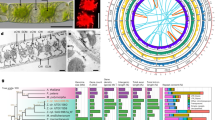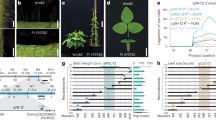Abstract
Fleshy fruits using ethylene to regulate ripening have developed multiple times in the history of angiosperms, presenting a clear case of convergent evolution whose molecular basis remains largely unknown. Analysis of the fruitENCODE data consisting of 361 transcriptome, 71 accessible chromatin, 147 histone and 45 DNA methylation profiles reveals three types of transcriptional feedback circuits controlling ethylene-dependent fruit ripening. These circuits are evolved from senescence or floral organ identity pathways in the ancestral angiosperms either by neofunctionalisation or repurposing pre-existing genes. The epigenome, H3K27me3 in particular, has played a conserved role in restricting ripening genes and their orthologues in dry and ethylene-independent fleshy fruits. Our findings suggest that evolution of ripening is constrained by limited hormone molecules and genetic and epigenetic materials, and whole-genome duplications have provided opportunities for plants to successfully circumvent these limitations.
This is a preview of subscription content, access via your institution
Access options
Access Nature and 54 other Nature Portfolio journals
Get Nature+, our best-value online-access subscription
$29.99 / 30 days
cancel any time
Subscribe to this journal
Receive 12 digital issues and online access to articles
$119.00 per year
only $9.92 per issue
Buy this article
- Purchase on Springer Link
- Instant access to full article PDF
Prices may be subject to local taxes which are calculated during checkout






Similar content being viewed by others
Data availability
All data that support the findings of this study are available from the corresponding author upon request.
References
Coombe, B. G. The development of fleshy fruits. Annu. Rev. Plant. Physiol. 27, 207–228 (1976).
Tiffney, B. H. Vertebrate dispersal of seed plants through time. Annu. Rev. Ecol. Evol. Syst. 35, 1–29 (2004).
McMurchie, E. J., McGlasson, W. B., & Eaks, I. L. Treatment of fruit with propylene gives information about the biogenesis of ethylene. Nature 237, 235–236 (1972).
McManus, M. T. The plant hormone ethylene. (Wiley–Blackwell, Hoboken, NJ, 2012).
Barry, C. S., Llop-Tous, M. I., & Grierson, D. The regulation of 1-aminocyclopropane-1-carboxylic acid synthase gene expression during the transition from system-1 to system-2 ethylene synthesis in tomato. Plant Physiol. 123, 976–986 (2000).
Giovannoni, J., Nguyen, C., Ampofo, B., Zhong, S., & Fei, Z. The epigenome and transcriptional dynamics of fruit ripening. Annu. Rev. Plant. Biol. 68, 61–84 (2017).
Manning, K. et al. A naturally occurring epigenetic mutation in a gene encoding an SBP-box transcription factor inhibits tomato fruit ripening. Nat. Genet. 38, 948–952 (2006).
Vrebalov, J. et al. A MADS-box gene necessary for fruit ripening at the tomato RIPENING INHIBITOR (rin) locus. Science 296, 343–346 (2002).
Zhong, S. et al. Single-base resolution methylomes of tomato fruit development reveal epigenome modifications associated with ripening. Nat. Biotechnol. 31, 154–159 (2013).
Liu, R. et al. A DEMETER-like DNA demethylase governs tomato fruit ripening. Proc. Natl Acad. Sci. USA 112, 10804–10809 (2015).
Sato, S. et al. The tomato genome sequence provides insights into fleshy fruit evolution. Nature 485, 635–641 (2012).
Vrebalov, J. et al. Fleshy fruit expansion and ripening are regulated by the tomato SHATTERPROOF gene TAGL1. Plant Cell 21, 3041–3062 (2009).
Lin, Z., Zhong, S., & Grierson, D. Recent advances in ethylene research. J. Exp. Bot. 60, 3311–3336 (2009).
Guo, H. & Ecker, J. R. Plant responses to ethylene gas are mediated by SCF(EBF1/EBF2)-dependent proteolysis of EIN3 transcription factor. Cell 115, 667–677 (2003).
Lee, T. H., Tang, H., Wang, X. & Paterson, A. H. PGDD: A database of gene and genome duplication in plants. Nucleic Acids Res. 41, 1152–1158 (2013).
Périn, C. et al. Molecular and genetic characterization of a non-climacteric phenotype in melon reveals two loci conferring altered ethylene response in fruit. Plant Physiol. 129, 300–309 (2002).
Kunieda, T. et al. NAC family proteins NARS1/NAC2 and NARS2/NAM in the outer integument regulate embryogenesis in Arabidopsis. Plant Cell Online 20, 2631–2642 (2008).
Guo, Y., & Gan, S. AtNAP, a NAC family transcription factor, has an important role in leaf senescence. Plant J. 46, 601–612 (2006).
D’Hont, A. et al. The banana (Musa acuminata) genome and the evolution of monocotyledonous plants. Nature 488, 213–217 (2012).
Golding, J., Shearer, D., Wyllie, S., & McGlasson, W. Application of 1-MCP and propylene to identify ethylene-dependent ripening processes in mature banana fruit. Postharvest. Biol. Technol. 14, 87–98 (1998).
Liang, C. et al. OsNAP connects abscisic acid and leaf senescence by fine-tuning abscisic acid biosynthesis and directly targeting senescence-associated genes in rice. Proc. Natl Acad. Sci. USA 111, 10013–10018 (2014).
Roy Choudhury, S., Roy, S., Nag, A., Singh, S. K. & Sengupta, D. N. Characterization of an AGAMOUS-like MADS-box protein, a probable constituent of flowering and fruit ripening regulatory system in banana. PLoS One 7, e44361 (2012).
Elitzur, T. et al. Banana MaMADS transcription factors are necessary for fruit ripening and molecular tools to promote shelf-life and food security. Plant Physiol. 171, 380–391 (2016).
Primack, R. B. Relationships Among Flowers, Fruits, and Seeds. Annu. Rev. Ecol. Syst. 18, 409–430 (1987).
Tieman, D. M., Ciardi, J. A., Taylor, M. G. & Klee, H. J. Members of the tomato LeEIL (EIN3-like) gene family are functionally redundant and regulate ethylene responses throughout plant development. Plant J. 26, 47–58 (2001).
Ríos, P. et al. ETHQV6.3 is involved in melon climacteric fruit ripening and is encoded by a NAC domain transcription factor. Plant J. 91, 671–683 (2017).
Pirona, R. et al. Fine mapping and identification of a candidate gene for a major locus controlling maturity date in peach. BMC Plant Biol. 13, 166 (2013).
Schwartz, Y. B. & Pirrotta, V. Polycomb silencing mechanisms and the management of genomic programmes. Nat. Rev. Genet. 8, 9–22 (2007).
He, Y. Chromatin regulation of flowering. Trends. Plant. Sci. 17, 556–562 (2012).
Acknowledgements
This work is supported by Hong Kong UGC GRF-14119814/14104515 and Area of Excellence Scheme AoE/M-403/16 to S.Z., Shenzhen Peacock-KQTD201101 to J.Z., Spanish Ministry of Economy and Competitively grant AGL2015-64625-C2-1-R, Centro de Excelencia Severo Ochoa 2016-2020 and the CERCA Programme/Generalitat de Catalunya to J.G.-M., and National Science Foundation IOS-1339287 to Z.F. and J.G.
Author information
Authors and Affiliations
Contributions
S.Z. designed the research; P.L., N.Z., Y.C., B.Z., Y.P., J.F., J.A., N.Y. and J.Z. performed the experiments. S.Y., D.T., S.Z. and J.X. analysed the data. D.G., J.G.-M., Z.F., J.G. and S.Z. wrote the paper.
Corresponding author
Ethics declarations
Competing interests
The authors declare no competing interests.
Additional information
Publisher’s note: Springer Nature remains neutral with regard to jurisdictional claims in published maps and institutional affiliations.
Electronic supplementary material
Supplementary Information
Supplementary Text, Supplementary Methods, Supplementary References and Supplementary Figs. 1–27.
Supplementary Tables 1–18
Supplementary Table 1: Summary of genome assembly and annotation used in this study. Supplementary Table 2: Sample description, sequencing and mapping statistics of paired-end RNA-Seq data. Supplementary Table 3: Sample description, sequencing and mapping statistics of single-end RNA-Seq data. Supplementary Table 4: Summary of differentially expressed genes (DEGs). Supplementary Table 5: Summary of DNase-seq data. Supplementary Table 6: Summary of DHS data and associated genes. Supplementary Table 7: Distribution of DHS in different genome features. Supplementary Table 8: Statistics of tissue-specific DHS. Supplementary Table 9: Sample description, sequencing and mapping statistics of BS-Seq data. Supplementary Table 10: Statistics of differentially methylated regions (DMRs). Supplementary Table 11: Summary of ripening genes associated with promoter DNA hypomethylation and ripe fruit tissue-specific DHS. Supplementary Table 12: List of ripe-specific DEGs that are associated with promoter DHS and DNA hypomethylation. Supplementary Table 13: Summary of histone modification and transcription factor ChIP-Seq. Supplementary Table 14: Number of genes assocaited with H3K27me3. Supplementary Table 15: Summary of genes associated with differentially methylated H3K27me3. Supplementary Table 16: Expression of DNA demethylases in different plant species. Supplementary Table 17: Expression of ethylene biosynthesis genes in different plant species. Supplementary Table 18: List of published datasets used in this study.
Supplementary Tables 19–34
Supplementary Table 19: Normalized expression (FPKM) of apple genes. Supplementary Table 20: Normalized expression (RPKM) of banana genes. Supplementary Table 21: Normalized expression (FPKM) of cucumber genes. Supplementary Table 22: Normalized expression (FPKM) of grape genes. Supplementary Table 23: Normalized expression (FPKM) of Melon genes. Supplementary Table 24: Normalized expression (FPKM) of papaya genes. Supplementary Table 25: Normalized expression (FPKM) of peach genes. Supplementary Table 26: Normalized expression (FPKM) of pear genes. Supplementary Table 27: Normalized expression (FPKM) of strawberry genes. Supplementary Table 28: Normalized expression (FPKM) of tomato genes. Supplementary Table 29: Normalized expression (FPKM) of watermelon genes. Supplementary Table 30: Tomato genes associated with RIN ChIP-Seq peak. Supplementary Table 31: Tomato genes associated with TAGL1 ChIP-Seq peak. Supplementary Table 32: Tomato genes associated with EIN3 ChIP-Seq peak. Supplementary Table 33: Peach genes associated with NAC ChIP-Seq peak. Supplementary Table 34: Genes associated with tissue-specific H3K27me3.
Rights and permissions
About this article
Cite this article
Lü, P., Yu, S., Zhu, N. et al. Genome encode analyses reveal the basis of convergent evolution of fleshy fruit ripening. Nature Plants 4, 784–791 (2018). https://doi.org/10.1038/s41477-018-0249-z
Received:
Accepted:
Published:
Issue Date:
DOI: https://doi.org/10.1038/s41477-018-0249-z
This article is cited by
-
Dissection of mRNA ac4C acetylation modifications in AC and Nr fruits: insights into the regulation of fruit ripening by ethylene
Molecular Horticulture (2024)
-
A distal enhancer guides the negative selection of toxic glycoalkaloids during tomato domestication
Nature Communications (2024)
-
Origin and evolution of the triploid cultivated banana genome
Nature Genetics (2024)
-
Identification and virus-induced gene silencing (VIGS) analysis of methyltransferase affecting tomato (Solanum lycopersicum) fruit ripening
Planta (2024)
-
Wheat TaAP2/ERF Genes Regulate Heat Tolerance Through Ethylene Signaling at Grain-Filling Stage
Journal of Plant Growth Regulation (2024)



